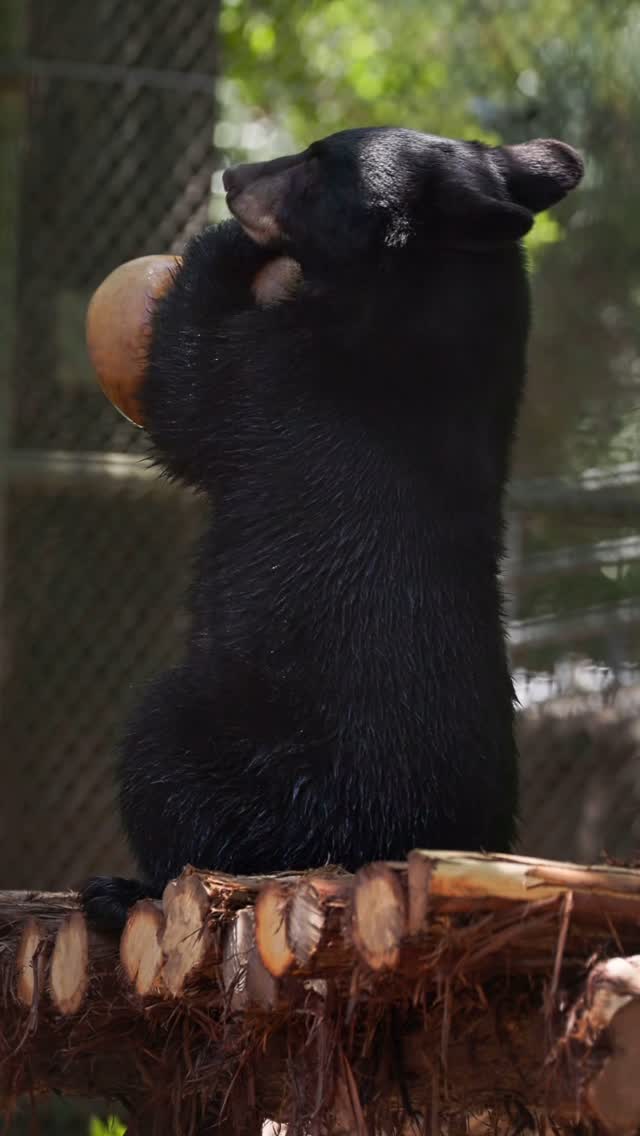- Importance of play in animal behavior and cognitive development
- Conservation implications of playful interactions in wildlife
- The role of environmental enrichment in captivity
- Understanding bear behaviors through observational studies
- Utilizing playful behaviors to foster engagement in ecological initiatives
The significance of play in animal behavior is a fascinating area of study within zoology. Play serves a crucial role in the cognitive development of various species, including bears. Observing young bears engaged in play provides essential insights into their learning processes. When a young bear interacts with objects, like a gourd, it not only sharpens its motor skills but also underlines the bear’s natural instincts.
Research has consistently shown that play is not just a trivial activity for animals. For many species, it’s a fundamental aspect of their development. In young bears, for instance, play can help them learn important survival skills. As they wrestle and tumble, they practice techniques that could be vital for hunting in the wild. This engaging behavior prepares them for real-world scenarios. Importantly, adult bears often engage in play as well, which further demonstrates its significance across different life stages.
The broader implications for conservation are worth noting. Understanding play in animals can help inform conservation efforts. When species are observed in their playful states, it allows researchers to gauge their mental and emotional well-being. In regions where habitat loss is rampant, studying playful behaviors may yield information about how stressors affect wildlife. Such insights are critical for developing conservation strategies that consider not only the physical but also the psychological health of animal populations.
Environmental enrichment is another essential aspect to consider. In captivity, animals often face challenges related to boredom and lack of stimulation. Providing opportunities for play, like introducing a gourd as a toy, can significantly improve the quality of life for animals in zoos or rehabilitation centers. Environmental enrichment involves creating stimulating conditions that replicate natural habitats. This reduces stress and encourages natural behaviors.
For example, in a zoo setting, the use of varied materials can inspire play. A gourd, when tossed around or manipulated, becomes a source of interaction. This simple object can mimic hunting or foraging behavior. Play activities can enable captive bears to express a range of behaviors, promoting mental and physical health. The success of these initiatives underscores the importance of keeping captive wildlife engaged.
Studies have revealed that bears in enriched environments exhibit more natural behaviors. Younger bears that play more frequently show greater adaptability to their environments, whether they are in the wild or under human care. Observational studies have recorded the effects of environmental enrichment on bear behavior, indicating increased exploration and reduced signs of stress.
Understanding bear behaviors through such studies enriches our perspective on these animals. Captive environments offer researchers a unique opportunity to monitor interactions closely. Observational studies can reveal much about social structures and interactions among bears. Notably, layered social groups can become evident during playtime. Younger bears often position themselves to learn from older ones, mimicking movements and tactics.
Playing together fosters bonds within social groups. This becomes critical in the context of wildlife conservation. Knowing how bears socialize aids conservationists in creating better strategies for habitat restoration. By prioritizing social structures, initiatives can operate more effectively to support bear populations in the wild.
Exploring playful behaviors not only aids in scientific understanding but also serves as an engaging tool for public awareness. Utilizing animals’ innate tendencies to play can increase community interest in wildlife conservation. Engaging the public through educational programs and events can highlight the importance of preserving natural habitats. Connecting playful animal interactions to educational initiatives strengthens the case for protecting ecosystems.
Interactive experiences can increase empathy and awareness surrounding wildlife. For example, events that showcase playful animal behaviors can create a deeper public appreciation for bears and their roles within their ecosystems. Educational messages emphasizing the effects of habitat loss, poaching, and climate change can spark conversations about conservation.
Educational campaigns can utilize the bear’s playful nature as a metaphor for the broader ecosystem. Like the bear playing with a gourd, the interconnectedness of all species can be illustrated, showing how environmental changes affect wildlife dynamics. This narrative can resonate with community members and encourage them to take personal responsibility regarding conservation.
The significance of playful behaviors extends beyond mere entertainment value. Play acts as a barometer for the health of animal populations. Captive environments that encourage play demonstrate the critical links between animal welfare and conservation. Watching animals engage in what seems to be simple play highlights broader lessons about the intricacies of their lives, both in the wild and in captivity.
Understanding how bears play provides a glimpse into their cognitive abilities, social structures, and ecological roles. This understanding is vital for the ongoing efforts in wildlife conservation. As play continues to shape the behaviors of young bears, it simultaneously informs our strategies for preserving their species. By observing and studying these playful interactions, researchers gain insights that are crucial for effective conservation planning.
The narrative of the bear and its playful nature extends into larger discussions of environmental stewardship. Recognizing that even simple actions, like tossing a gourd, can engage various audiences opens up avenues for further educational initiatives. The playful nature of bears becomes a powerful tool for advocacy, fostering a strong connection between people and wildlife.
Communities that participate in protecting local habitats can bridge personal experiences with broader conservation goals. By sharing the joy of animals at play, initiatives can become catalysts for action. Encouraging individuals to become stewards of their environments can result in enhanced support for larger conservation efforts. Individual actions, guided by understanding the enjoyment and significance of wildlife interactions, can contribute to fostering sustainable ecosystems.
The playful aspects of animal behavior, whether in the wild or in controlled settings, reveal deeper truths about the necessity for balanced ecosystems. Each action taken to understand and support wildlife reflects a commitment to preserving the delicate balance of nature. Observing behaviors like "Gourd overboard!" in young bears reminds us of the intrinsic joy and importance of wildlife.
Engaging with the public in a way that highlights the value of play can change the narrative around conservation. By focusing on the lively interactions of animals, more people can become advocates for wildlife protection. Playful behaviors not only inform research but also bridge connections between humans and nature, creating a collaborative approach to conservation.
Fostering community initiatives centered around wildlife creates shared responsibility toward the environment. As we appreciate playful moments of bears, we are reminded of the vital roles all species play in maintaining ecosystems. Promoting education about these interactions encourages deeper understanding and advocacy for environmental preservation, emphasizing the interconnectedness of all living beings.
Through observation and education, we can pave the way for more profound respect for wildlife while advancing efforts to protect their natural habitats. Playful interactions, especially in species like bears, can become a conduit for success in conservation. By emphasizing the importance of these behaviors, society can cultivate better environmental stewardship, increasing support for wildlife conservation initiatives worldwide.
*****
Source Description
Gourd overboard! 🤣
Everything becomes a toy when you’re a little bear! 🐻


